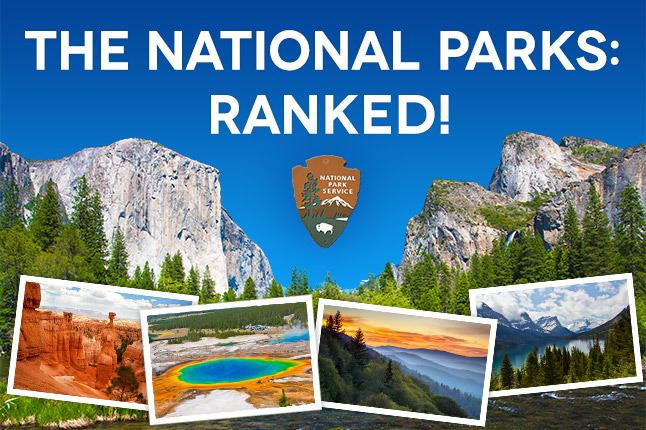The National Parks: Ranked! 2013
We may receive a commission on purchases made from links.
Writer Wallace Stegner once called national parks "the best idea we ever had." And, for the most part (Bill of Rights and Declaration of Independence—"We hold these truths to be self-evident," etc. etc.—aside), we agree with him. "Absolutely American, absolutely democratic," he went on, "they reflect us at our best rather than our worst."[slideshow:988]
That's certainly true. After all, what could be more impulsively democratic than to set aside your most spectacular, ecologically unique and culturally important land not for the use of the wealthy and privileged few, but for everybody to enjoy for all of time? It's what makes the national parks the greatest national treasure on Earth—more valuable than the British Crown Jewels or even Egypt's ancient cultural artifacts.
Click here to see a ranking of the 59 U.S. national parks.
Ever since Yellowstone was established as the world's first national park in 1872, we as a nation have placed more than 52 million acres of soaring mountains, primordial forests, rugged coastlines and wildlife-rich grasslands into the public trust in 59 national parks. I own them just as much as you own them, just as much as Donald Trump owns them. It's a great idea, indeed, and the symbolism and promise of the parks alone is enough to make us love each and every one of them.
So why bother ranking them? Because it's never been done before. And because, unlike men and women, we don't think that all national parks are necessarily created equal. While each one has its own particular strengths and singularities that make it, in its own right, something spectacular and worthy of preservation, there are also factors—accessibility, size, range of landscapes, diversity of activities available to the public, biodiversity and straight-up awe factor (that stunning scenery that you can conjure in your head even now)—that set parks apart in terms of overall visitor experience.
It feels a bit like parents picking our favorite child, but we earnestly wanted to know how each park stacked up against the others. How would the hundreds of miles of underground passageways in Mammoth Cave fare against the Dr. Seuss-worthy boulders and trees of Joshua Tree? How do southern Utah's red rock parks—Arches, Canyonlands, Zion, Bryce Canyon and Capitol Reef—compare? And which, if any, of the so-called "Crown Jewel" parks would top the list?
It's a Sisyphean task, no doubt, but one we hope will serve our readers, result in an engaging dialogue and, in the end, celebrate the awesome accomplishment that is the U.S. National Park System.
Click here to see where your favorite park ranked.
There are hundreds of criteria you could use to judge or rank a collection as big and diverse as the American national parks, from objective measures like park size and annual visitation to subjective measures like scenic value. For our ranking, we chose three—biodiversity, range of visitor activities and (here's the subjective one) the opinions of an expert panel.
We think biodiversity—the number of plant and animal species living there—is a good measure of a park's biological value. It indicates, to a degree, a diversity of landscape and habitats and reinforces the need to conserve that place as wilderness. This accounts for 25 percent of each score.
Range of visitor activities—including things like hiking, fishing, winter sports, bird watching and camping—is simply a nod to the overall visitor experience. Which parks best meet the assorted needs of the most diverse population on earth? This, too, accounts for 25 percent of each score.
For our panel of experts, we asked 17 writers, landscape photographers and travel professionals to do the impossible—name their 20 favorite national parks. These are people who write about and study the national parks, and spend much more time in them than your average person. Among those who helped out were Kurt Repanshek, editor of National Parks Traveler; Michael Joseph Oswald, author of the exhaustive Your Guide to the National Parks: The Complete Guide to All 58 National Parks; Mel White, author of National Geographic's Complete National Parks of the United States; Dan Austin, founder and owner of ace travel company Austin-Lehman Adventures; parks guidebook author Randy Johnson; Joel Saferstein, owner of American Park Network; Robert Earle Howells, editor of National Geographic's The 10 Best of Everything National Parks, and nature photographer QT Luong, who's captured every park on his large format camera and was featured in Ken Burns's documentary The National Parks: America's Best Idea. Even recently departed Interior Secretary Ken Salazar weighed in, though he couldn't choose favorites, saying, "I must admit the temptation to take on this task. However, I will not because all 401 are my favorite children. And that doesn't take into account our 560 Wildlife Refuges or the many units of our National Landscape Conservation System." In the end, their responses were entirely subjective—a mix of personal experience and how well each one felt his or her picks served the American people. Their votes accounted for 50 percent of each score.
So take a peek at the list, and be prepared to swallow your anger when you see that your favorite Alaskan park is only #50, or roll your eyes when you read which iconic park took #1, or even be pleasantly surprised that three eastern parks made the top 20. But try not to hold it against us. We do, after all, love them all equally.
—Peter Koch
Click through to see 59 stunning photos of our best national parks.
*Additional reporting by Jess Scanlon.
